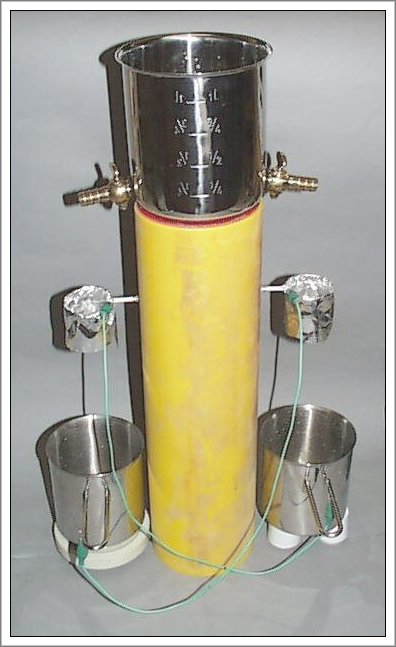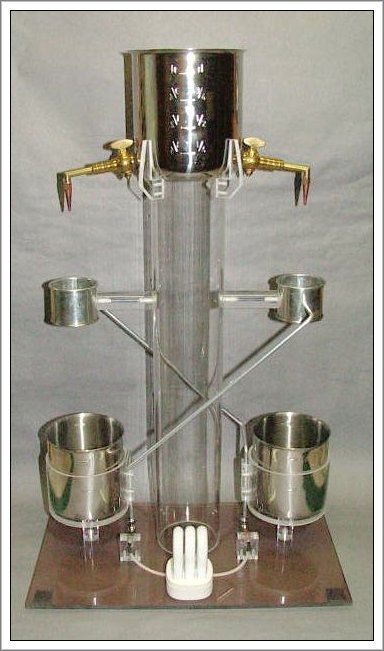


Some people have reported to me difficulties in getting this device to work.
You need to have some good clean fresh water for this thing to work,
I tried normal rainwater stored in plastic tank here and it did not work either.
I charged this water up using a vande graf generator and the dripper then worked as described although not well.
I think water from a reservour supply may not work as well as it sits in a storage area and with metal pipes and this is subjected to chlorine and flouride and the ambient heat to keep it drinkable although nature lovers would consider this water dead.
I may be wrong but if you can get some pure clean mountain or running spring water you may be more successful.
if the water is chilled to 4 degree celsius this may also help as water seems to lose something when heated
by the hot sun when out in the open
The best water it seem to be something stored in darkness and kept chilled if you are to believe followers of Viktor Schauberger
If you used poly pipe this stuff when it gets damp will conduct electricty away from the cans and I suggest you varnish all the plastic of it using a natural vanish not the petrol chemical version or use a better supporting material.
Wood restorers or hardware suppliers may be the source to try.
The water also has to drip and not be a continous stream but a drip by drip operation.
If the air is moist around the device such as high humidity or rain in the air ,it will not work also as the charge will not be allowed to build up due to the water conducting the charge into the surrounding enviroment.
It should however work great if you have a thunderstorm , A good dry environment is what you are seeking.
if others out there have suggestions that make this device work I would welcome your input here
Geoff
From an associate of the original inventor of the Kelvin Can experimental device.
Subject: Re: Kelvin Generator
Apologies for not replying earlier, I have been away.
We use ordinary tap water, which in this area is quite 'hard', with high
mineral content. We tried using distilled water but it wouldn't work
properly.
Please note the webmaster has found that rainwater stored in Plastic storage tank for a long period of time does not work as well.
We also found that if you lightly greased the grey plastic
pipework with silicon grease or similar, the effect was a much inproved
spark gap & faster spark repetition.
This seems to prevent water build
up on the pipework which we found affected charge build up.
Under no circumstances get any kind of detergent such as washing up
liquid anywhere near it, as this kills the charge build up immediately!
Hope this helps. Please let us know how you & everyone else get on.
Regards, Ian Helliwell.
In the late 19 th century and early 20 th century there was performed a nearly forgotten experiment that generated static electricity. by lord Kelvin
This a modified form that will give better results.
The frame work is made of PVC tubing that holds 4 x 1.5kg empty coffee tin cans or anything made of metal.
The top of the upper two tins will contain small plastic micro garden sprinklers popularly used and very cheap.
Both of the bottoms of the uppermost cans have about a two inch centre hole to allow water to drip into can below..
The two bottom cans have there tops completely removed and small holes punched in the bottom of each can to allow water to drip into a common collection tray.
Water is pumped through the plastic tube from the collection tray via a small car windscreen water pump and sent to the two sprinklers mounted in the lids and then the water drips through the can until it reaches the collection tray.
distance between top and bottom can should be such that water drips and is not a continuous flow.
Wire leads are connected to di-anglar cans and then to a spark gap terminal
When water is flowing a spark should be generated every twenty seconds experimentation will be needed to adjust the spark gap for better results.
from email letter
This is from my memory from investigations I made in 1970. Stuff at the end was done prior to me circa 1965. Work was conducted at UMASS, mine was for a senior lab project (I don't have a copy of my report nor the others.
1. Atmospheric Potential differential.
I played with this device many years ago. From what I understand Kelvin designed it to prove that there existed potential differential in the atmosphere. So the first thing we did was to enclose the device in a grounded cage to eliminate any potential differential. Of course the device still worked. The device seemed to function best on dry days as opposed to humid/damp atmosphere.
2. Fluid.
We also used several several types of fluids including triple distilled water to minimize any conductivity of the flowing fluid. The type of fluid utilized also appeared to have little effect.
3. Upper ring size/polarity/separation.
We got no significant output due to the diameter/length of the upper rings/cans. We discovered that whichever ring/can was higher always produced the same polarity. Once the machine was running and discharging on of the fluid streams could be turned off and the device continued to function.
Horizontal separation of the upper/ower rings also seemed to yield little diffenence.
4. Upper ring - Lower can seperation.
This dimention did have a significant effect but my 'gray matter' is seeping into my hair and I forget details.
5. Spray and encapsulation.
Instead of water drops we usually used a continuous flow of fluid from the pipets. Entering the upper ring was a narrow stream that kept increaseing into a larger funnel shape. When a 2-8K potential was reached the spark gap discharge snapped the funnel back into a stream and the process repeated. This tended to 'wet down' the device. I therefore had the desire to encapsulate the stream to avoid this condition but was never sucessful.
6. Patent.
Some UMass mechanical prof (circa mid 1975)applied for and I beleive (incredibly) was granted a patent for this device as a potential for generating electricity.
Other strange stuff I remember.
Heat disipation. I remember seeing a picture of a hot-plate with the 6 in diameter coil glowing red except for a portion directly below a 1 inch charged probe. That area was cold black. Never played with that myself and I don't know the polarity or voltage. If true. it looked like it sucked down a lot of heat.
Garden Plots.
Three graden plots were encased in cages, one as a baseline, one with the mesh charged positively, the other charged negatively. The baseline grew normally while one of the charged ones grew terrible and the other superceeded the baseline (don't remember the polarity of which was which).
Just passing on what little I know
Peter b.
Other experimenter's Lord Kelvin device's photo's


Movies
Lord Kelvin water drop experiment setup
Lord Kelvin water drop experiment
